#emitaï
Explore tagged Tumblr posts
Text













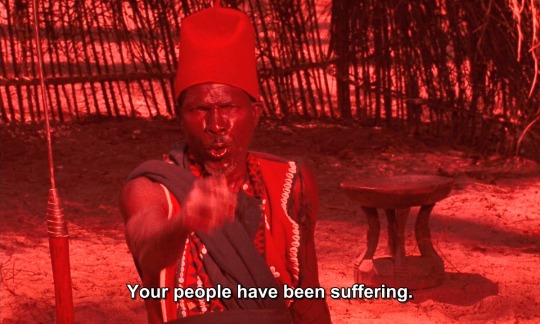
















EMITAÏ (1971) dir OUSMANE SEMBENE
22 notes
·
View notes
Text








Ousame Sembène's "Emitaï" July 1971.
#Ousmane Sembène#Emitaï#1971#Seventies#Foreign#🇸🇳#Drama#Political Drama#War Drama#World War II#WWII#Colonization#Stills
3 notes
·
View notes
Text

2 notes
·
View notes
Text
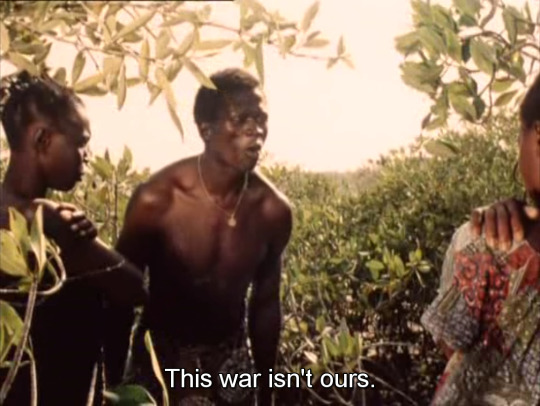
Emitaï (Ousmane Sembene, 1971)
Cast: Andongo Diabon, Robert Fontaine, Michel Renaudeau, Osmane Camara, Ibou Camara, Alphonse Diatta, Pierre Blanchard. Screenplay: Ousmane Sembene. Cinematography: Georges Caristan, Michel Renaudeau. Film editing: Gilbert Kikouïne.
I grew up on Hollywood films, which were all that were available in the small town where I lived. (This was before cable TV, not to mention streaming.) They made me love movies, but they also gave me a limited awareness of what film could do. So when foreign films finally became part of my movie-watching life, I was astonished at how little I knew about what cinema could be, but also about how limited my experience of human behavior was. The people in the French and Italian and Swedish films I saw didn't behave the way people in American movies did and the way the filmmakers told their stories was somehow different from the way Hollywood did. There were fewer happy endings and predictable plot turns. And when I moved beyond European films into the work of Asian directors, there was still more culture shock coming. But as my cinematic horizons widened, and I came to embrace Satyajit Ray along with Nicholas Ray, to rank Ozu and Renoir among my favorite directors alongside Hitchcock and Hawks, there still remained (and remains) an ignorance of what's called "world cinema," the work of filmmakers outside the developed countries of Europe and Asia. I still approach these movies with a bit of trepidation, uncertain whether the differences between the cultures they show and my own will stymie my understanding and appreciation of their work. So I'm working my way through the Criterion Channel's collection of the films of Ousmane Sembene with a kind of divided awareness. I have to remind myself that these movies weren't made for me, but for an African audience. There's a kind of urgency about his films that's more vital for the intended audience than it is for me. Emitaï is set in Senegal during World War II, when the French drafted the native people of their colonies into the fight. It takes place in a village that resents having its young men taken away and its rice crop collected as taxation. But there's no resisting the superior arms of the French authorities, and the film evokes the impotence and frustration of the villagers. The elders decide to call on their gods, which we actually see in a fantasy sequence, but they get no help. Sembene depicts the latent strength of the tribe, especially its women, but this conflict of cultures can only end tragically. Sometimes, Sembene's storytelling relies on blatantly expository dialogue and didactic speeches that verge on propaganda, but this is anything but naïve filmmaking. Emitaï is a subtle and poignant depiction of the destructive absurdity of colonialism.
1 note
·
View note
Text
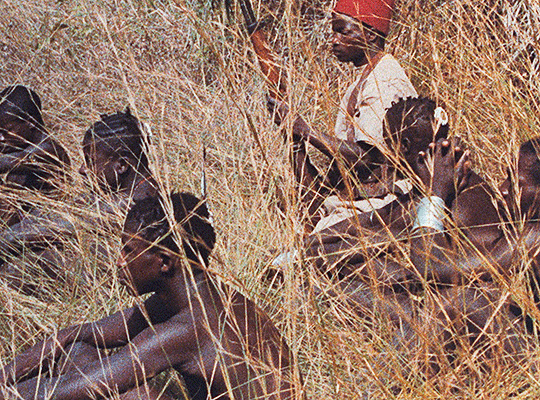
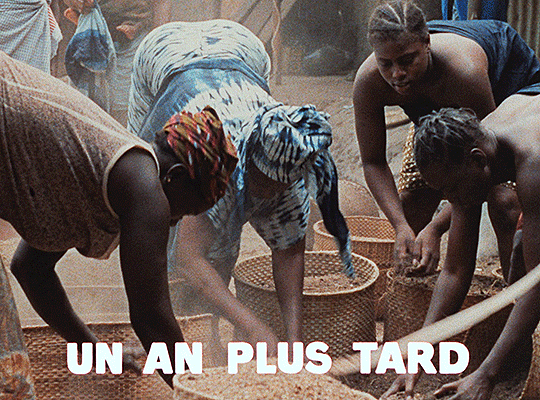


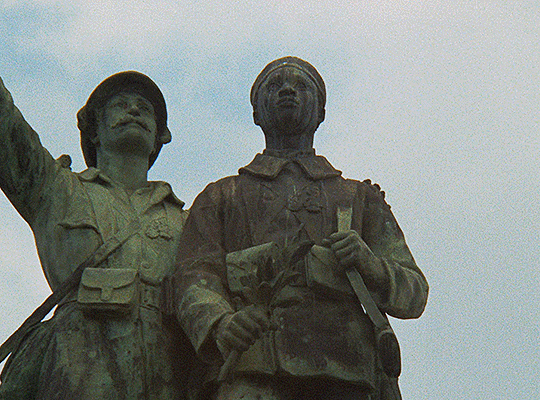
Emitaï (1971) Directed by Ousmane Sembène
#Emitai#filmgifs#moviegifs#fyeahmovies#african cinema#senegal#1970s#uservintage#userfilm#filmedit#tw: 'gun'#worldcinemaedit#ours#by natty
113 notes
·
View notes
Text
2 notes
·
View notes
Text

Emitaï (1971, Ousmane Sembène, Senegal)
3 notes
·
View notes
Photo










Emitaï (Sembène, 1971)
#emitaï#emitai#ousmane sembène#ousmane sembene#sembene#sembène#sembene ousmane#ibou camara#ousrnane camara#joseph diatta#dji niassebanor#robert fontaine#michel renaudeau#pierre blanchard#cinema#film#senegal#france
20 notes
·
View notes
Photo

Emitaï (1971, Senegal)
In 1963, Borom Sarret became the first African film to be directed a black African. I imagine many people reading that last sentence are thinking to themselves, “what took so long?” Simple: colonial governments forbade film productions by native Africans. With Senegal becoming independent from France in 1960, this allowed Ousmane Sembène to be the first black African director on a short (Borom Sarret) and a feature-length film (1966’s Black Girl). Before Borom Sarret, Sembène was primarily an author residing in France (he smuggled himself to Paris in 1947) – his literary works commented on colonialism, racism, identity, and tribal relations. Around 1960, Sembène found himself fascinated with films and wished to experiment in how to express his ideas through a visual medium. Studying filmmaking for a year in Moscow gave him the skill needed to return to Senegal, intent on crafting films for his fellow Senegalese (Senegal recorded a 51.9% literacy rate in 2017, so Sembène’s writing was inaccessible to many), to help them see and understand the lives and cultures similar or dissimilar to their own.
Sembène, born to a Lebou family among fellow tribespersons, turns his focus to the Diola – an ethnic minority also known as Jola – people for Emitaï (sometimes translated to “God of Thunder”, but it refers to a supreme, remote being). The Diola have a language quite different from Wolof, Senegal’s lingua franca, and the Diola language has several dialects. While directing Emitaï, Sembène learned the specific dialect used by the villagers used as extras in this film. That local dialect is the language used in the film, not Wolof as many websites and film databases online claim. Here, we learn how – through the Diola’s culture – they comprehend and react to the dilemma they contend with in this film. Soon enough, the audience learns of the spiritual richness of the tribe depicted and witnesses the French characters’ contempt towards the Diola’s way of life. Emitaï is a remarkable film, paced to the tempo of life in a rural village, and deeply attuned to storytelling traditions not often honored in film.
Somewhere in the Casamance region of Senegal, black Vichy French soldiers are abducting several Diola tribesman, forcibly conscripting them into service. Vichy France fought with the Axis powers, as it was a puppet state of Nazi Germany. Back in the village, the tribal elders are discussing if they should respond, given that these abductions are interfering with the rice harvest. No action is taken and the film progresses one year. It is the summer of 1944. French colonial officers – Robert Fontaine (“Monsieur” in Black Girl) as the Commandant, Michel Remaudeau the Lieutenant (as well as cinematographer), Pierre Blanchard the Colonel – follow orders to enforce a severe rice tax on tribal villages. They dispatch a detachment of black troops to that Diola village to levy said tax (this detachment includes the men abducted the prior year). As the conscripts round up the locals, the tribal leaders consult their animistic gods and the women rebel against the French officers and the tribesmen-turned-soldiers.
Emitaï tells its story at its own pace. The camera is kept apart from tribespersons and French soldiers alike, keeping them in a full or medium shot, rarely employing close-ups. The surrounding nature is depicted to suggest the villagers’ relationship with nature. Winds sigh through the trees and tall grasses, the nearby marshes (maybe unclaimed by agriculture) form the background for the rice harvesting scenes, and we hear nothing but the sloshes of water during a boating scene. Conversations between individuals, a group, or antagonistic groups develop, intensify, and subside without a cut taking the viewer to someplace else. The conversations are self-contained within the seconds or minutes they occur between characters or groups; the effectiveness of these scene is thanks to the fact that the characters believably are without certain knowledge about what is happening in other parts of the village. There are no knowing winks to others (or the audience), no clever asides that would feel inappropriate in a tale of colonial oppression. Yet, Sembène’s film never putters in philosophical circles nor feels plodding. Less patient filmmakers or those who too stubbornly subscribe to postmodernism might feel unsettled here, wishing to whisk the audience from a scene before a Major Plot Reveal (this might be culturally compatible with Sembène’s or the Diola’s understanding of how they share stories) with their itchy fingers. Sembène uses this time to help viewers learn about the Diola. Whether one might be a non-Diola from Senegal or from the other side of the Earth, we learn basic aspects about Diola culture that amplifies how we feel when we see the villagers being rounded up and young, able-bodied men who just happened to evade French capture taking arms against African-wielded, European-engineered munitions.
The Diola worship and fear their gods, and the rice they harvest is not only for themselves, but used as an offering to their gods. And as the tribal elders communicate with the gods, the quality of their rice harvest may impact how their gods converse with them – there is one fantastical sequence where this occurs. Some viewers might see the dialogue with the gods as a delusion, an unnecessary detour in an allegedly straightforward colonizer-versus-colonized narrative. But recall that Sembène wanted to make films so that his fellow Senegalese – no matter their ethnicity, linguistic skills, or religion – could empathize or see their histories onscreen. The Diola believe in these animistic gods to keep their families and villages at peace (although – though not portrayed in the film – some Christian and Islamic influences have been introduced), to guide them when an enemy is bearing down on them. Who are we to say they are wrong for doing so? Sembène, who also wrote the screenplay, may not have been Diola himself, but he clearly showed enough respect and attention to them that he would allow their gods have a presence in Emitaï. A Diola did not write Emitaï, but those moments with the gods – a daring decision that I am unaware has any such parallels in a colonizer-versus-colonized film – and the inclusion of a few funeral ceremony scenes complement the “voice” of the Diola. Traditions of African folk stories and religions are prevalent in how Emitaï is shot and how its story unfolds – including, as a pervasive convention in these traditions, a tree that connects humans to a spiritual plane.
The tribal leaders in Emitaï appear to be all men. The women of the village are mostly seen as tending to the children, as well as performing the bulk of the rice harvest. They are the first to be detained by the forcibly conscripted soldiers, but not in a position of distress. After a skirmish between some of the young, uncaptured men and the French forces, the women arrange an impromptu funeral procession for one of the fallen tribal leaders. They sing what sound like celebratory, not mournful, songs – perhaps for a life well lived, bravery in defending the Diola way of life. What should be uncontroversial becomes rebellion. With forcible conscription may result in further encroachments on Diola culture. Already their sacred harvest is disrupted, so what might be next? In Black Girl, Sembène’s feminist arguments circulated around personal discontent and racial subjugation. Though not nearly as intimately portrayed here, Emitaï expands on those themes – showing us the solidarity of the oppressed women. None of the black characters in Emitaï are professional actors and none of the women are given character names. Nameless though they may be (perhaps this was an attempt to “universalize” the film to the tribal peoples of Senegal), the village’s women seldom appear helpless as the conscripted soldiers force them into position by the sides of their rifles or the French officers barking at them about the location of hidden rice. Unarmed and forced to sit in the baking sun, they are stronger that anyone might guess.
Their understanding of “the white man’s war” is limited and the Diola feel little responsibility in helping the French officers fight it. A message delivered in the final minutes reveals that Marshal Philippe Pétain (Vichy France’s leader) has been deposed by Charles de Gaulle, meaning that the Allies have liberated France from the Axis (Sembène – who himself was drafted into France’s colonial infantry and later served among the Free French Forces – makes a cameo appearance here as the soldier ridiculing de Gaulle for being ranked lower than Pétain). Leadership has changed thousands of miles away, but the situation for all the native Africans – soldiers and civilians alike – is unchanged. Allied victory has brought not liberation, but a new poster of some mustachioed, uptight Frenchman who just happens to now be in charge. The casual cruelty and cultural ignorance on display by the French – as they complain of the backwardness of where they are stationed and how the most consequential decisions are being made by military bureaucracy – is rather restrained. Though it would be difficult to recall any nobility among the French soldiers, they do possess a cartoonish, outward malice. Sembène castigates the French characters and colonialism not through soliloquies, but their escalations and actions. Emitaï’s most violent moment is never shown on-camera, yet it was enough to provoke French censors to scrub the scene (among others). Ironically, despite Senegal’s independence from France eleven years prior, this meant the film could not be released in its entirety in France or French-speaking Africa until 1976 – five years after its debut at the Moscow International Film Festival.
Nor did Sembène catch a break from Senegalese censors. President Léopold Senghor’s regime censored Sembène’s films regularly: Sembène’s next feature, Xala (1975), excoriated colonialist institutions that remained in Senegal post-independence and its lead actor was chosen partly due to his resemblance to President Senghor (it doesn’t help that the plot revolves around the lead character looking for a cure for his sudden impotence). In the case of Emitaï, the reasons are not readily available, but the censorship most likely was targeted towards how the forcibly conscripted soldiers are depicted. The dynamic that the Senegalese censors singled out in Emitaï would be multiplied and inflamed by Sembène’s Ceddo (1977) – that film is set shortly after France establishes a colonial government in Senegal; there, Sembène draws parallels between that film’s tribal leaders and future Africans who would conspire with European slave traders (the Senegalese government’s perceptions that the film criticized Senegal’s political leadership and bourgeoisie was accurate, but that is a story to be told when I review Ceddo).
An unofficial sequel to Emitaï was released in 1988, Camp de Thiaroye. That film touched upon many of the themes Sembène remarks upon in Emitaï: the destruction of identity among African soldiers in the French military, violence in the name of colonialism, and structures of racial supremacy. It, too, was censored in France and Senegal upon release. But by Emitaï, Sembène’s cinematic style – freed from the constraints of speech and linguistic barriers – had become crystallized. Like his prior works, Emitaï is uncompromising in its depiction of human cruelty and how that is manifested in colonial or neocolonial paradigms. He criticizes so effectively by juxtaposing behavior, not through rhetoric – it matters not if the oppressor is white (as they almost always are in his films) or black. Away from urban settings, his pacing adapts to the surrounding environment, the slow and seasonal life of the Diola village. Many who see Emitaï will not recognize much of the life and culture of the Diola. It is a testament to Sembène that he makes this biting film so empathic and compelling.
My rating: 9/10
^ Based on my personal imdb rating. Half-points are always rounded down. My interpretation of that ratings system can be found here.
#Emitai#Emitaï#Ousmane Sembene#Ousmane Sembène#TCM#Andongo Diabon#Robert Fontaine#Michel Renaudeau#Ousmane Camara#Ibou Camara#Alphonse Diatta#Pierre Blanchard#Cherif Tamba#Fode Cambay#Michel Remaudeau#My Movie Odyssey
4 notes
·
View notes
Photo

Emitaï (Ousmane Sembène, 1971) a senegalese village during world war 2. first the french come for their young and able men, then they come for their rice. village elders caught between capitulation to their gods or the military, while their women roast in the sun. petain’s ousted, de gaulle’s instated, but no change is felt here.
7 notes
·
View notes
Text

Emitaï, Ousmane Sembène (1971)
2K notes
·
View notes
Text











EMITAÏ (1971) dir OUSMANE SEMBENE
17 notes
·
View notes
Text

Ousmane Sembène’s “Emitaï” July 1971.
#Ousmane Sembène#Emitaï#1971#Seventies#Foreign#🇸🇳#Drama#World War II#WWII#Political Drama#Dramedy#3/5
2 notes
·
View notes
Text
Notes on Barbara McCullough at Scribe Video Center
Barbara (Alhorn) McCullough
LA rebellion (they did not pick this name) 1967-89
UCLA archives began to archive projects and then they began to receive accolades
Shopping Bag Experience
Horace Tapscott
Grew up in fam of Jazz Musicians, raised by blind father, NOLA, had 3 kids while attending school
Representation, experimentation and Directorial Choices
Influences:
Emitaï by Sembene (father of African cinema) Documentary called Sembene!
Betye Saar (mystical print works, altered states of consciousness) The liberations of aunt Jemima
Senga Nenguni- nylon stockings-elasticity of body and mind. Performance artist
Zora Neale Hurston- Mules and men writer AND filmmaker, went thru the south collecting stories (fieldwork 1928) she didnt present herself as detached, she would interact w subjects, she called herself an observant participant
Maya Deren- ritual and transfigurative time, studied w Catharine Dunham and studied Haiti
Horace Tapscott musical griot
"Beyond representation but bearing witness to authenticity and realistic truth"
In both lit and film
See her slide
How can I be truthful that provided clarity and not imposition
Grass value switcher?
She uses archival stills to provide testimony
Who are the new Jazz ppl? She originally wanted to do a huge project but no funding, his performances were free, jazz artists perform hoping their work won't b co-oped
SBS: what is ritual?
Many of her choices were pivoting bc of no funding. Photo montage helped so much
I don't think artists of her caliber should be looking for money it should just be there for her.
SBS started as a class project
Used grass valley switcher for otherworldly looks
Ritual questions came from when she lived in a community of women she lived with who had rituals who used water.
Weave imagery w real-time responses
Ritual is restoring balance of energy
Eyes open during Muslim prayer, eyes open while facing ground to remember death
The woman felt she was someone else while dancing like Ife -senga
Ritual- rite vs right Betty
You can hear Barbara say "mhmm" during interviews, she doesn’t feel the need to remove herself from interviews. She does mixed media and sees it as ritual because placing items becomes its own ritual.
Horace in the white tux was unplanned at the talk she filmed him at. She didn't reenact except for one performance
Pics of his hands moving while he speaks juxtaposed with his hands on the piano
One camera
Multiple images at the same time
Piece of the the images falling into place and THEN revealing full image
He was targeted by COINTELPRO, stopped by police and told to stop playing jazz
Watts rebellion used her fireplace to rep this rebellion
1977-1991
Tapscott performed for the last time in NY
Her rebellion background and Horace
Sometimes u get sick of showing someone else
Charles Burnett got an oscar.
It was very fulfilling to hear Barbara McCullough speak. It was sobering as well. Why does a great mind like hers need to struggle? She should be getting paid to speak at grand universities but she doesn’t seem to mind speaking in a small room without air conditioning or speakers. I’m struggling with my own parameters of success because exposure neither indicates reverence nor acceptance. I try not to feel discouraged, but I just think things should be a bit easier for her.
I guess I have no right for any type of righteous indignation because she seems happy, ready to fight, ready to film, ready to pivot. These are things that are hard for me as a filmmaker even now. She seemed unfazed by minor inconveniences and fully resolved the greater challenges she witnessed as a young revolutionary filmmaker. I guess her desire is based on a need for the craft and not striving for acceptance. She represents the art of film in it’s purest film. You film because you have to, because it is the best language for you to communicate, because there is nothing you would rather do.
#Barbara McCullogh#women filmmakers#Scribe video center#black women filmmakers#mfa colloquium#mfa colloquium 3#film#cointelpro
1 note
·
View note










